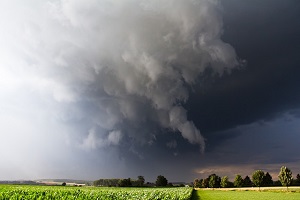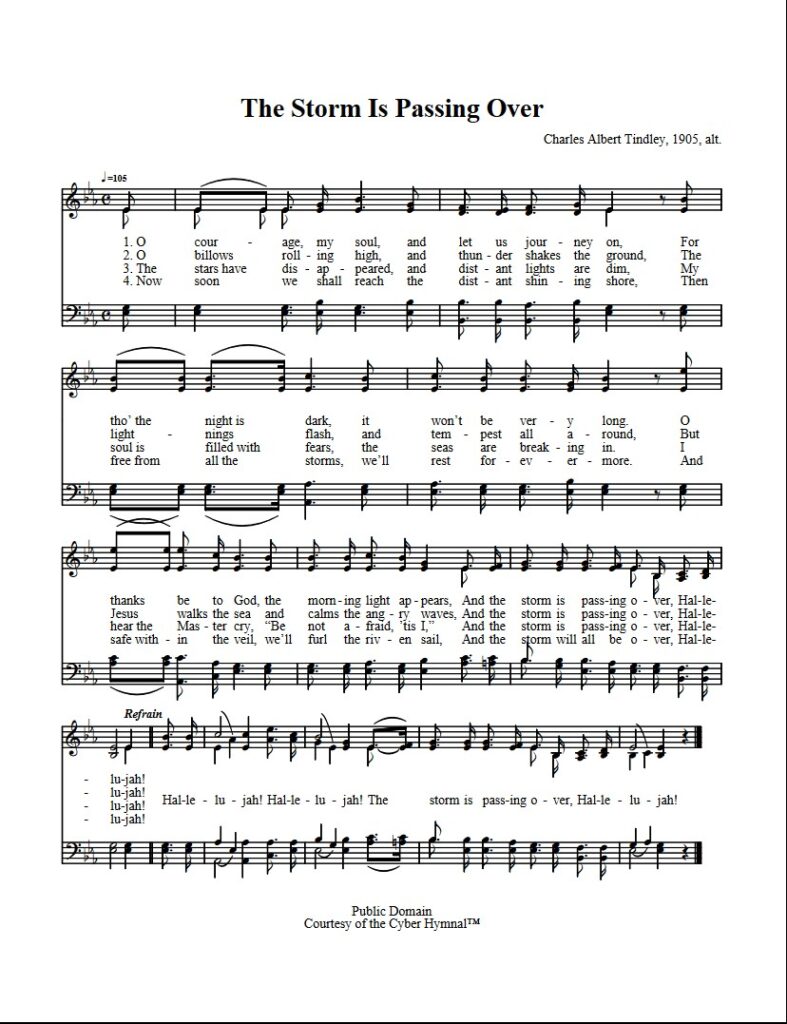
I’ve said this many times before and will say it again here: You just never know what you’re going to find when you start looking up information about a piece of music. My choir, the Cherry Creek Chorale here in the Denver area, is closing its October 2022 concert with the piece “The Storm Is Passing Over.” The composition credit is listed as “Charles Albert Tindley, arranged by Barbara W. Baker.”
So the obvious question was, “Who were these people?” Let me start with Tindley, a fascinating figure in American history who was born before the Civil War and ended up as the pastor of a 10,000-member mega church. And this was before mega churches were even a thing. A-a-a-a-a-nd, he’d been the janitor of that church to begin with. It’s a great, great story. Tindley was the son of a slave father and a free mother (how that happened I have no idea), considered to be free himself because of her. When his mother died he went to live with his mother’s sister in order to keep his free status. But he was expected to earn his keep, as it were, and was routinely “hired out,” never having the opportunity to attend school. Here’s what Wikipedia has to say:
Tindley learned to read by sitting by fire light and sounding out letters and eventually words from pieces of paper with writing that he found. [Another source says that these were scraps of newspaper that had been thrown in the trash and he retrieved.]
He mastered reading so well that later he enlisted the help of a Philadelphia synagogue on North Broad St. to learn Hebrew. He later learned Greek by taking a correspondence course through the Boston Theological School.
He often used his hymns as part of his sermons, breaking into song to make a point. How he learned music in addition to everything else is beyond me. He’s now recognized as one of the founders of American Gospel music, and his “I’ll Overcome Someday” is seen to be the source of the great civil rights anthem “We Shall Overcome.”
You’ll be able to see his original version of “The Storm Is Passing Over” below; the tune has significant differences from what’s used today and the words to the additional verses don’t show up much in modern arrangements. Sometimes Tindley is given credit only for the lyrics, but that’s not really fair. I’ve found a few performances online that are closer to his version than the usual, so you can take a listen to the one I included and see what you think.
But let’s move on to this whole idea of “arrangements.” Anyone can take a song or other piece of music and make changes to it, including the key, the rhythm, the accompaniment, the words, or the melody—although that last one can’t be changed too much or the so-called arrangement just becomes a new piece. If the original is still under copyright then the arranger has to (ahem) make arrangements with the holder of the copyright. (Sorry.) If you’re working with something in the public domain then you don’t technically have to list the original auhor, and you certainly don’t have to get permission. But it’s always a good idea to acknowledge your sources. Then you’re safe from any plagiarism charges, and why not give credit where it’s due? You look like the good guy, and you have a backstory to tell about your own work.
So I’ve been pleased to see that Tindley is almost always credited as at least the lyricist for “Storm.” The few exceptions I’ve seen list Donald Vails, who was the leader of a great Black Gospel group called the Choraleers back in the 1980s and 90s. His tune is very close to the one typically used today, but it’s an a cappella version. So now we get to the current version that my own choir is singing, with a totally great accompaniment, by a renowned choral conductor named Barbara Wesley Baker. She, like Tindley, is one of those people whose bio is exhausting—and that’s just for the people reading it! As far as I can tell she’s still living, but a scouring of the internet for any contact info has yielded nothing. It would be interesting to know if she realized that the tune she was using had really been developed by Vails. Not only does she provide a piano part but also includes performance notes that suggest the use of a rhythm section. I’m also immensely tickled to read that “the pianist is free to add chords and gospel piano styling such as doubling of bass notes, high octaves, fill-in notes, and the like.” Having attended a church all during my growing-up years with accomplished pianists playing in this style for the congregational singing, I can relate totally to what she’s saying. She also added indications over almost every single note about the articulation: is it staccato, marcato, or tenuto? We’ve all been trying very hard to keep them straight as we work on the piece. (Are you reading this post before Oct. 14/15 2022, and do you live in the Denver area? Then follow this link to buy tickets for our concert.)
Note that I haven’t called this song a “spiritual.” I’ve gone ahead and included that category for the post, but technically it isn’t a true spiritual, because those are always anonymous because they’re folk songs. But it’s nevertheless a spiritual song. Just to be clear.
Well, enough of that. What we really need is the music, right? So below is a total feast of videos that you can plow through or listen to at your leisure. They’re all seriously great. Here goes:
First, what I found to be a great performance by a non-church group:
And then, what is probably THE DEFINITIVE performance of this song, broadly based on the Vails version but with lots of changes in rhythm and lots of repetition:
And now here’s a performance of an arrangement that’s much closer to Tindley’s original, by yet another arranger, Rollo Dilworth:
And, FINALLY, the original hymn from the great Charles Tindley himself:


